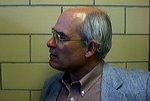In 1905 Albert Einstein (1879–1955) (Figure 1.6), an obscure Swiss patent examiner who was also a PhD candidate in physics, surprised the scientific world by publishing three extraordinary papers on physical phenomena. The first paper on the particle nature of light won him the Nobel Prize in 1921. One of the other two papers explained Brownian motion, the previously unexplained movements commonly observed in microscopic systems. Molecules themselves were causing the movement. The third paper eventually made him a worldwide celebrity; its topic was special relativity. In it, he demonstrated that time was a necessary fourth dimension to the three dimensions of space and that energy and mass were equivalent (E = mc2). When he extended that paper in 1915 to include gravity (general relativity) and when his theoretical predictions were later empirically confirmed, Einstein became a worldwide celebrity.
Einstein’s surprises were startling. His equations showed that time and space were not invariant, but that they changed depending on the motion of the observer. The equations also indicated that gravity warped space itself, a prediction confirmed by Edington’s observations of stars during a solar eclipse in 1919. At the atomic level, Einstein’s definition of light as quanta (small packets of light energy), led to the development of quantum mechanics, which was yet another scientific surprise. Like Galileo and Darwin before him, Einstein prompted a completely new worldview in which very small or very fast particles followed rules unlike any in the observable world.
Last night, the History Channel, broadcast a television documentary on Einstein which added much detail about the efforts empirical scientists underwent in order to confirm his predictions. That detail is provided by a new book, Einstein's Jury, by Jeffrey Crelinsten. In it, he shows how astronomers attempted to measure the predicted deflection of light caused by the Sun's immense gravity. Attempts were made in Crimea in 1914, but were interrupted by World War I. Another attempt was made by the Lick Observatory in America during the war. After the war ended, Eddington, a pacifist and a Quaker, thought that confirming Einstein's theory would do much to alleviate the deep discords between European scientists.
However, the solar eclipse of 1919 was observed by several groups of astronomers other than Eddington. Also, the Lick data, collected with second-rate equipment (the state-of-the-art telescopes were still in Russia, having been seized in 1914), showed that Einstein's prediction was wrong. News of Eddington's confirming but preliminary analyses made it to London at the same time that the Lick astronomers were about to announce the lack of agreement with the theoretical prediction. When they heard of the discrepancy, William Wallace Campbell, the head of the Lick group, delayed publication.
When Eddington fully analyzed the data, he confirmed Einstein's prediction that gravity did indeed deflect light, thus undermining classical Newtonian mechanics and making Einstein world famous, nearly instantly.
Here is the link to the December 2, 1919 New York Times story on Einstein and general relativity.
Einstein’s surprises were startling. His equations showed that time and space were not invariant, but that they changed depending on the motion of the observer. The equations also indicated that gravity warped space itself, a prediction confirmed by Edington’s observations of stars during a solar eclipse in 1919. At the atomic level, Einstein’s definition of light as quanta (small packets of light energy), led to the development of quantum mechanics, which was yet another scientific surprise. Like Galileo and Darwin before him, Einstein prompted a completely new worldview in which very small or very fast particles followed rules unlike any in the observable world.
Last night, the History Channel, broadcast a television documentary on Einstein which added much detail about the efforts empirical scientists underwent in order to confirm his predictions. That detail is provided by a new book, Einstein's Jury, by Jeffrey Crelinsten. In it, he shows how astronomers attempted to measure the predicted deflection of light caused by the Sun's immense gravity. Attempts were made in Crimea in 1914, but were interrupted by World War I. Another attempt was made by the Lick Observatory in America during the war. After the war ended, Eddington, a pacifist and a Quaker, thought that confirming Einstein's theory would do much to alleviate the deep discords between European scientists.
However, the solar eclipse of 1919 was observed by several groups of astronomers other than Eddington. Also, the Lick data, collected with second-rate equipment (the state-of-the-art telescopes were still in Russia, having been seized in 1914), showed that Einstein's prediction was wrong. News of Eddington's confirming but preliminary analyses made it to London at the same time that the Lick astronomers were about to announce the lack of agreement with the theoretical prediction. When they heard of the discrepancy, William Wallace Campbell, the head of the Lick group, delayed publication.
When Eddington fully analyzed the data, he confirmed Einstein's prediction that gravity did indeed deflect light, thus undermining classical Newtonian mechanics and making Einstein world famous, nearly instantly.
Here is the link to the December 2, 1919 New York Times story on Einstein and general relativity.




No comments:
Post a Comment